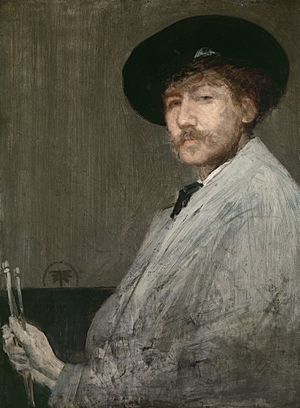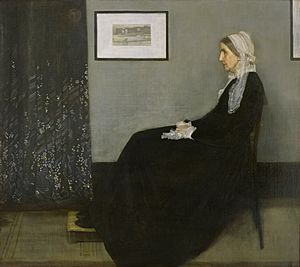James Whistler facts for kids
Quick facts for kids
James Abbott McNeill Whistler
|
|
|---|---|

Arrangement in Gray: Portrait of the Painter
(self portrait, c. 1872), Detroit Institute of Arts |
|
| Born |
James Abbott Whistler
July 10, 1834 |
| Died | July 17, 1903 (aged 69) London, England
|
| Nationality | American |
| Education | United States Military Academy, West Point, New York |
| Known for | Painting |
|
Notable work
|
Whistler's Mother |
| Movement | Founder of Tonalism |
| Awards |
|
James Abbott McNeill Whistler (born July 10, 1834 – died July 17, 1903) was an American artist. He lived mostly in the United Kingdom. He was active during a time in American history called the Gilded Age. This was a period of fast economic growth.
Whistler's most famous painting is Arrangement in Grey and Black No. 1. It is usually called Whistler's Mother. Whistler had a big impact on the art world. He shared his ideas about art. He was also friends with many important artists and writers of his time.
Contents
Early Life of James Whistler
James Abbott Whistler was born in Lowell, Massachusetts. He spent his first three years in a small house there. Today, this house is a museum about him.
Young James was often moody. He sometimes felt lazy after being sick. His parents found that drawing helped him calm down. It also helped him focus his attention.
Time at West Point
Whistler first went to Christ Church Hall School. His family hoped he would become a minister. But James always had his sketchbook with him. His classmates liked his funny drawings of people.
It soon became clear that he was not meant for a religious career. So, he applied to the United States Military Academy at West Point. He got into this tough school in July 1851. This was partly because of his family's good name. He also had very poor eyesight and health.
He stayed there for three years. His grades were just good enough to pass. He looked messy during drills and inspections. People called him "Curly" because his hair was too long. Colonel Robert E. Lee was the head of West Point. He was patient with Whistler for a long time. But in the end, he had to ask the young cadet to leave.
Whistler's main success at West Point was learning to draw. He also learned map making. His teacher was the American artist Robert W. Weir.
Whistler's First Job
After leaving West Point, Whistler got a job. He worked as a draftsman. A draftsman draws detailed plans or maps. His job was to map the entire U.S. coast. This was for military and shipping purposes.
Whistler found this work very boring. People found out he was drawing sea serpents, mermaids, and whales. He drew them in the blank spaces of the maps. So, he was moved to a different department. This was the etching division of the U.S. Coast Survey.
He only stayed there for two months. But he learned the art of etching. This skill later became very important for his art career.
Whistler's Mother Painting

In 1871, Whistler created his most famous painting. It is a full-length picture called Arrangement in Grey and Black No.1. Most people know it as Whistler's Mother. It uses mostly shades of one color.
One day, a model did not show up. So, Whistler asked his mother to pose for him. At first, he had her stand. But that was too tiring for her. So, she sat down in the famous pose we see today. It took many sittings to finish the painting.
The painting looks simple, but it is very clever. It balances different shapes. The rectangles of the curtain, the picture on the wall, and the floor balance the curves of her face, dress, and chair.
The painting almost burned in a train fire while being shipped. Later, the French government bought it. This was the first of Whistler's works to be in a public collection. It is now in the Musée d'Orsay in Paris.
During the Great Depression, the painting was called a "million dollar" artwork. It was very popular at the Chicago World's Fair. People all over the world saw it as a symbol of motherhood. In 1934, the United States even put an image of the painting on a postage stamp.
In 2015, an art critic named Peter Schjeldahl wrote about the painting. He said it is "the most important American work residing outside the United States."
Images for kids
-
Portrait of Whistler with Hat (1858), a self-portrait at the Freer Gallery of Art, Washington, D.C.
-
Nocturne: Blue and Gold - Old Battersea Bridge (1872), Tate Britain, London
-
Alice Butt, c. 1895, National Gallery of Art
-
Zaandam, the Netherlands, c. 1889 – etching by James McNeill Whistler
-
The Doorway, etching and drypoint, 1879–80, Metropolitan Museum of Art
-
The Princess from the Land of Porcelain, in situ in The Peacock Room, Freer Gallery of Art, Washington, D.C.
-
Nocturne in Black and Gold: The Falling Rocket (1874), Detroit Institute of Arts
-
Mother of Pearl and Silver: The Andalusian (1888–1900), National Gallery of Art, Washington, D.C. (Model: Ethel Whibley)
-
Arrangement in Pink, Red and Purple, 1883–1884, Cincinnati Art Museum, Cincinnati, Ohio
-
Maud Franklin Arrangement in White and Black, 1876. Freer Gallery of Art, Washington, D.C.
-
Whistler by William Merritt Chase, 1885. The Metropolitan Museum of Art.
See also
 In Spanish: James McNeill Whistler para niños
In Spanish: James McNeill Whistler para niños





































